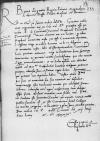List #2152
Bona Sforza do Ioannes DANTISCUSCracow, 1539-05-12
| odebrano [1539]-05-25 Rękopiśmienne podstawy źródłowe:
Publikacje:
| ||||||||||||
Tekst + aparat krytyczny + komentarzZwykły tekstTekst + komentarzTekst + aparat krytyczny
Reverendo in Christo Patri, domino
Reverende in Christo Pater, sincere nobis dilecte.
Gratum nobis erat cognovisse nos ex cf.
Speramus, quae petimus, nos impetrare debere. Vestra etiam Paternitas pro iure et auctoritate sua ius
Bene valeat Vestra Paternitas.
Dat(ae) or Dat(um)⌈Dat(ae)Dat(ae) or Dat(um)⌉
Commissio propria s(acrae) or s(erenissimae)⌈s(acrae)s(acrae) or s(erenissimae)⌉ reginalis maiestatis


 BCz, 3465, p. 286
BCz, 3465, p. 286